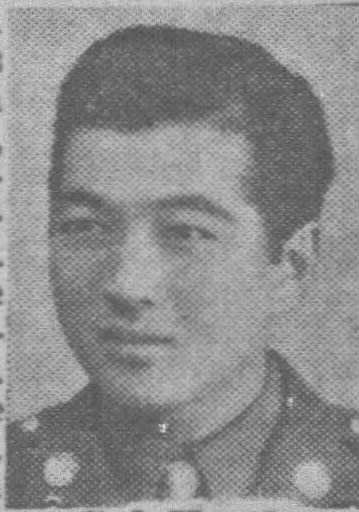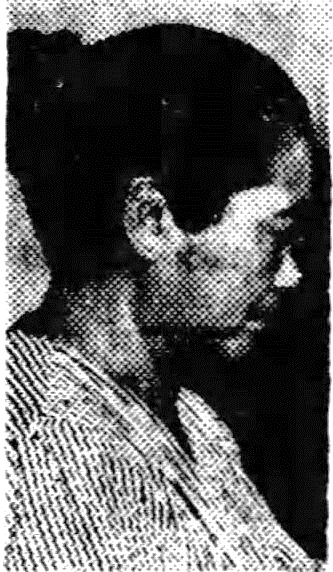
Takezo Kanda
Corporal
442nd Regimental Combat Team
3rd Battalion, Headquarters Company
Takezo Kanda was born on November 13, 1920, in Honolulu, Oahu, Territory of Hawaii. He was the son of Taketaro and Toku (Horisawa) Kanda. Taketaro emigrated on December 19, 1906. Both parents were from the town of Shiunji, Niigata Prefecture, Japan. Taketaro started his life in Hawaii as a laborer, but in 1913 he was on working as a brewer for the Hawaii Seishu Kwaisha, Ltd. – a sake brewing company. In 1920, he was the manager of a miso factory, and by 1930 he was a retail merchant. He owned the Kuhio Market and Florist Shop at 2648 South King Street in Honolulu. In 1940, Taketaro was no longer working and his wife, Toku, was managing the shop. He passed away that year. The name of their business was changed to the Kanda Store.
Takezo was educated at Kuhio School, Washington Intermediate School, and McKinley High School. Before the war, he played center position with the Moiliili Blue Devils barefoot football team in the Citywide-Palama League. Takezo registered for the draft on February 14, 1942, at Local Board No. 3, Honolulu National Guard Armory. He was 5’8½” tall and weighed 135 pounds. He was employed as a carpenter with the U.S. Army Engineers at Fort Shafter.
In early 1943, the formation of the 442nd Regimental Combat Team was approved and the call for Nisei volunteers went out. Takezo was one of the 2,645 Nisei selected from the 10,000 in Hawaii that answered that call, and on March 24, 1943, he enlisted in the U.S. Army at Schofield Barracks. At the time, he had completed three years of high school and his civilian occupation was listed as carpenter. He was sent to Boom Town, the “tent city” at Schofield Barracks, with other Nisei enlistees. On March 28, they were given a community farewell at Iolani Palace, and on April 4 they sailed on the S.S. Lurline to San Francisco. After a train trip across the US, they arrived at Camp Shelby, Mississippi, for training. He was assigned to the 3rd Battalion, Headquarters Company.
After months of training, the 442nd left Camp Shelby for Camp Patrick Henry, Virginia, on April 22, 1944. Takezo shipped out to Europe with the 442nd on May 2, 1944, from Hampton Roads, Virginia. The 442nd RCT arrived in Naples, Italy, on May 28, 1944, after crossing the Atlantic in a convoy of over 100 ships heading for the theater of war.
On June 26, 1944, the 442nd entered combat in the Rome-Arno Campaign near Suvereto. By mid-July, the Germans had been pushed north to Livorno (Leghorn), which fell on July 18. Third Battalion pushed farther north to the Arno River. On July 22 and 25, the Combat Team moved to a rest area near Vada, where they remained until August 16, when they were moved by truck east to Castelfiorentino. The Combat Team was then ordered to make a considerable show of strength along the south side of the Arno River, patrolling aggressively all along its front to keep the enemy off balance and worried about where the next strike would come. Patrols were very active, and engagements with the enemy were frequent.
On September 1, 1944, Corporal Takezo Kanda was killed in this action at Badia a Settimo, just west of Florence along the south side of the Arno River. He was acting as a litter bearer and went to the aid of a wounded soldier. To reach him, Kanda made his way through a minefield under enemy fire. After rescuing the man, Kanda then returned to the aid of another soldier. The jeep in which he evacuated the wounded men hit a mine and the explosion killed Corporal Kanda.
He was buried in the U.S. Military Cemetery at Vada, Italy, Section C, Row 11, No. 417.
Corporal Kanda was posthumously awarded the Silver Star Medal for his actions at Badia a Settimo, Italy, per General Orders No. 27, II Corps, issued July 9, 1945.
His family held a memorial service for him at 10:00 a.m. on October 8, 1944, at the Soto Mission on Nuuanu Avenue and School Street in Moiliili, Honolulu. He was survived by his mother, Mrs. Toku Kanda, proprietor of the Kanda Store at 2642 South King Street; five brothers, Takashi, Takeo, Satoshi, Suetake, and Toshio; and three sisters, Mrs. Yoshio Iwasa, Daisy Kikue, and Fumiko. On October 13, the family published a Card of Thanks in the Honolulu Advertiser for all the kindnesses and floral offerings received from friends and relatives during their recent bereavement.
For his military service, Corporal Takezo Kanda was awarded the Silver Star Medal, Bronze Star Medal, Purple Heart Medal with two oak leaf clusters, Good Conduct Medal, American Campaign Medal, European-African-Middle Eastern Campaign Medal with one bronze star, World War II Victory Medal, and Combat Infantryman Badge. Takezo Kanda was awarded the Congressional Gold Medal on October 5, 2010, along with the other veterans of the 100th/442nd Regimental Combat Team. This is the highest Congressional Civilian Medal.

On January 9, 1945, his mother, Toku Kanda, received his Purple Heart during a private ceremony held at the family home at 2638 S. King Street. The presentation was made by Lt. Colonel E.M. Blight of the Central Pacific Base Command on behalf of Lt. General Robert C. Richardson, Commander of Armed Forces-Mid Pacific.
Right: Mrs. Kanda at her son’s Purple Heart ceremony
Corp. Kanda was among the 226 Hawaii war dead from the 100th/442nd RCT to be memorialized at a service held on December 9, 1945, at 1:30 p.m. at the McKinley High School auditorium. The planning committee consisted of: Dr. Katsumi Kometani of the 100th Veterans Club (Club 100), Shigeo Okubo and Takao Hedami of the 442nd Veterans Club, Mr. Shigeko Marumoto and Miss Hideko Yoshimura of the Women’s War Service Association, and Dr. Ernest I. Murai of the Emergency Service Committee. The main speaker was Lt. General Robert C. Richardson.
In 1948, the Army began the process of closing the smaller military cemeteries in Italy and offering the family the choice of reburial at the large U.S. Military Cemetery in Florence or returning home. Corporal Kanda’s family chose to have his remains returned. He arrived on December 24, 1948, on the USAT Sinnett to Dock M-3 at Pearl Harbor with 121 other of Hawaii’s war dead. Over 700 family and friends were waiting on the pier where the 265th Army Band played Aloha Oe as the ship docked at 8:30 a.m. They were eulogized in a shipside service by the Secretary of Hawaii, Oren E. Long, who said, “We are proud to have had such sons. These men stood the test of action and added a new chapter of American heroism to our history.” The flag-draped caskets were taken to the Army mausoleum at Schofield Barracks awaiting burial arrangements.
Corporal Kanda was interred on September 19, 1949, at the National Memorial Cemetery of the Pacific at Punchbowl, Section Q, Site 1189, in Honolulu.
Researched and written by the Sons & Daughters of the 442nd Regimental Combat Team in 2020. Updated 2021.
